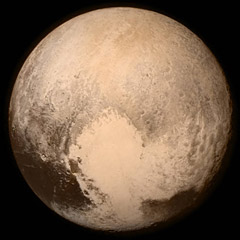 |
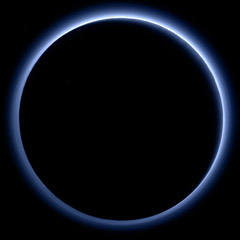 |
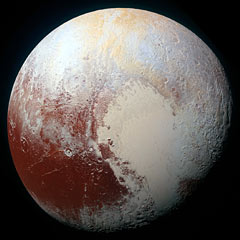 |
||
| New Horizons natural color photo of Pluto (NASA/JHUAPL/SwRI) | New Horizons photo of Pluto's far side showing its blue atmosphere (NASA/JHUAPL/SwRI) |
New Horizons enhanced color photo of Pluto showing surface details (NASA/JHUAPL/SwRI) |
| Back to Previous Stop | Return to Plutonian System |
Pluto | Continue Tour to Charon |
Continue to Next Stop |
God of the Underworld
As we leave the ice giants behind, we approach the outer limits of our solar system. This region is inhabited by many small, icy worlds. This region is known as the Kuiper belt, and two of its most famous inhabitants are the planet Pluto and its largest moon, Charon. The darkness and isolation of these two worlds has likened them to the underworld. In fact, Pluto was named after the Roman god of the underworld. Pluto was discovered in 1930 by Clyde W. Tombaugh at Lowell Observatory in Arizona. It was much too small to be seen by most telescopes of the time. Astronomers first theorized that a ninth planet might exist when they observed that something seemed to be exerting a gravitational pull on the planet Neptune. An in-depth sky survey finally turned up the tiny planet. Pluto is so far away from the Sun that it takes 248 Earth years to complete one orbit. The temperature here averages -382° F (-230° C).
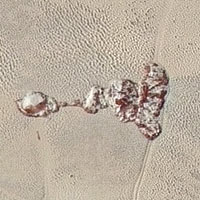 |
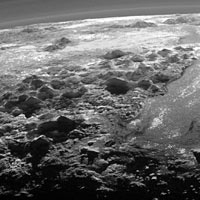 |
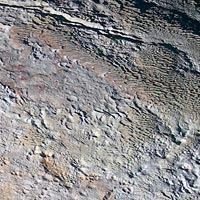 |
||
| Close-up image of Pluto showing ice mountains on a plain (NASA/JHUAPL/SWRI ) | Close-up image of of Pluto showing ice mountain ranges (NASA/JHUAPL/SwRI) |
Close-up image of Pluto showing rough textured mountains (NASA/JHUAPL/SWRI) |
The Twin Planets
For many decades, Pluto was thought to be alone in its dark corner of our solar system. But in 1978, astronomer Jim Christy discovered that Pluto had a companion. This moon, known as Charon, is more than half the size of its parent planet. In fact, many astronomers once referred to Pluto and Charon as "twin planets" because they are so close to each other in size. Because Charon is so large, it does not actually orbit around Pluto. Rather, the two bodies actually orbit around a common center of gravity somewhere between them. Pluto and Charon are also tidally locked in a synchronous orbit. Pluto's rotational period is 6.3 days. It takes 6.3 days for Charon to make one revolution around Pluto. Thus, the two bodies continuously face each other. The orbit of Pluto is so highly eccentric that is actually crosses inside the orbit of Neptune. Because of this, Pluto is actually closer to the Sun than Neptune for 20 years of its 248-year orbit. The 17-degree inclination of Pluto's orbit means that it there is no chance that it will eventually collide with Neptune. Because Pluto crosses Neptune's orbit, there is a very real possibility that the two worlds may collide at some point in the future.
In 2005, two new moons were discovered by the Hubble Space Telescope Pluto Companion Search Team on. Once the orbits were confirmed, the moons were assigned the names Nix and Hyrda. The names were chosen in part because the initials (NH) refer to the New Horizons mission, which explored Pluto in 2015. In Greek mythology, Hydra was the 9 headed serpent who guarded the waters of the underworld and Nix was the goddess of the night. Two additional moons were discovered in 2011 and in 2012, bringing the total to five. In keeping with the underworld theme, these new moons were named Styx and Kerberos.
Features of Pluto
Until recently, very little was known about the surface of Pluto. It is so tiny and so far away that even the Hubble Space Telescope was unable to resolve any surface features. With a diameter of only 1,473 miles (2,370 km), Pluto is not considered to be a true planet. Instead, it belongs to a relatively new category of objects known as dwarf planets. Until recently, no one really knew why this small, rocky object could be found among the giant gas planets of the outer solar system. But recent discoveries of many similar objects have answered that question. There may be hundreds or even thousands of Pluto-like objects lurking in the outer Solar System in the Kuiper belt.
In 2015, NASA's New Horizons spacecraft reached the Plutonian system after a voyage of over 9 years and 4.6 billion miles. Th spacecraft made its closest approach at only 7,750 miles (12,472 km) from the surface of the dwarf planet and captures amazing high-resolution images of Pluto and its largest moon Charon. New data showed that Pluto is about 50 miles (80 km) larger than previously thought and that it has a nitrogen-rich atmosphere extending tens of thousands of miles out into space. Images showed that Pluto's surface is quite varied, with large differences in both brightness and color. In fact, Pluto is one of the most contrastive bodies in the Solar System. The color varies between charcoal black, dark orange and white.
The most famous geographical feature on Pluto is a gigantic heart-shaped plain known as Tombaugh Regio. Other notable features include Cthulhu Regio, a large dark area on the trailing hemisphere resembling a whale, and the Brass Knuckles, a series of equatorial dark areas on the leading hemisphere. Other images showed large mountain ranges made entirely of water ice. One range known as Sputnik Planum rises 11,000 feet (3,500 meters) high.
The Lost Planet
For years, many astronomers questioned the status of Pluto as one of the nine planets of the Solar System. They believed that Pluto and Charon could be asteroids or comets that somehow got locked into an orbit around the Sun. Soon after the discovery of the Kuiper belt, most astronomers began to think that these two bodies were actually rogue Kuiper objects and should not longer be classified as planets. The debate raged on for decades, supported by the public's fondness for their favorite planet. Finally, on August 24, 2006, the International Astronomical Union (IAU) decided to redefine the definition of a planet. This decision officially reclassified Pluto and Charon as dwarf planets. Only 76 years after its discovery, Pluto was quietly added to the list of minor planets and given the number 134340. It was the end of an era as the Solar System's ninth planet surrendered its title.
Today, we know that many similar objects can be found in this region of space. In fact, over a dozen other similar objects have been discovered beyond the orbit of Pluto. Over 100,000 smaller objects have been found in the Kuiper Belt. The future holds the possibility of many exciting new discoveries as we continue to probe the darkness in search of Pluto's cousins.
The Sun
Mercury
Venus
Earth
Mars
Jupiter
Saturn
Uranus
Neptune
Pluto
Asteroids
Comets
Interstellar Space
Your Weight on Other Planets
|
||||||||
The Moons of Pluto |
|||||
Name |
Order |
Diameter |
Orbital Period |
Distance (km) |
Year |
|
Styx Nix Kerberos Hydra |
1 2 3 4 5 |
1,208 10 - 25 46 - 137 13 - 34 61 - 167 |
20.2 24.86 32.1 38.21 |
19,600 42,656 48,708 59,000 64,749 |
1978 2012 2005 2011 2005 |
| Back to Previous Stop | Return to Plutonian System |
Return to Top of Page |
Continue Tour to Charon |
Continue to Next Stop |



